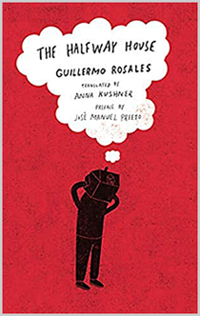The Halfway House by Guillermo Rosales, translated by Anna Kushner
by JP Poole
 Guillermo Rosales’s The Halfway House is a brilliant and stark portrait of what it’s like to live in multiple rings of exile, not unlike Dante’s multiple rings of hell. When the novel’s protagonist, William Figueras, arrives in Miami, his relatives expect to embrace a young Cuban exile ready to make it big in America. Instead, they lock eyes with someone they barely recognize—a rail thin stranger who hurls insults at them through missing teeth and is suffering from paranoia. Figueras is admitted to a psychiatric ward that day. He escapes Cuba only to enter the U.S. and be exiled again to the broken mental health care system, ending up in a privately-run halfway house that’s one tier better than living on the streets.
Guillermo Rosales’s The Halfway House is a brilliant and stark portrait of what it’s like to live in multiple rings of exile, not unlike Dante’s multiple rings of hell. When the novel’s protagonist, William Figueras, arrives in Miami, his relatives expect to embrace a young Cuban exile ready to make it big in America. Instead, they lock eyes with someone they barely recognize—a rail thin stranger who hurls insults at them through missing teeth and is suffering from paranoia. Figueras is admitted to a psychiatric ward that day. He escapes Cuba only to enter the U.S. and be exiled again to the broken mental health care system, ending up in a privately-run halfway house that’s one tier better than living on the streets.
The halfway house, where this slender novel is set, is a human rights nightmare. William’s aunt drops him off at the doorstep, after it’s clear he’s too mentally ill to make his way in the world. The owner of the house, Mr. Curbelo, collects government checks from the residents and leaves them to live in squalor. While Curbelo is away on fishing trips, a man named Arsenio is in charge. He spends his time stealing from residents, beating them up, and sexually assaulting an elderly female resident. The book is consistently unsettling to read. The descriptions of roaches, no clean towels, no toilet paper, limited food, clogged toilets, and urine-stained hallways are visceral symbols of how corruption works under capitalism. Curbelo knows that no one will stop him from fleecing people who are poor and, as William says, “nuts.”
William turns to literature to maintain his sanity. He carries around a book of English poets, and the book offers quotes from Coleridge (and others) as brief moments of beauty amidst the dirt, stink, and grime of the house. He states, “By the age of fifteen I had read the great Proust, Hesse, Joyce, Miller, Mann.” He’s also a writer, who wrote a book in Cuba that was deemed a failure for its critique of the communist party and led to William’s first psychotic breakdown. Without basic necessities, such as food, hygiene supplies, and competent medical care there’s little that a poem written by Lord Byron can do to prevent William from turning a dark corner.
Living in the halfway house causes William to change. “Fifteen years ago, I was a good-looking guy. I was a lady-killer.” He soon becomes someone who seems capable of murder. He meets a new resident, Frances, and falls in love with her. He also begins a ritual of choking her. She begs him to kill her. Like William, Frances is an artist; she makes sense of the world by drawing what she sees—portraits of the residents at the halfway house. She is William’s last chance at redemption and the hope of a normal life.
There’s no easy way of saying this: The Halfway House is one of the most disturbing books I’ve ever read—disturbing because what Rosales captures about the machine of corruption is unmistakably true. This halfway house that he describes exists in America, a democracy, that claims life, liberty, and the pursuit of happiness for all. The book points to the fact that the American dream cannot exist without capitalism. There are always those who are willing to abuse the poor. The corrupt Mr. Curbelo is living a carefree life of leisure only because he’s willing to not provide residents with soap, thereby increasing his wealth. If there is a “happy” character in the book it’s him. His dream turns the residents’ lives into a waking nightmare.
The Halfway House tells the story of the many political systems that can break the human spirit to the point of no return. The book does not have a happy ending, just as it does not have a happy beginning. Nevertheless, I was entranced by the raw, honest beauty of Rosales’s prose. The first sentence reads: “The House said ‘Boarding Home’ on the outside, but I knew it would be my tomb.” The novel springs from the truth of Rosales’s life. He was diagnosed with schizophrenia and died by suicide at the age of forty-seven. His characters, he says, “are Cubans affected by Castro’s totalitarianism, human wrecks.” The city of Miami is a place where some find refuge and others find only hell.
